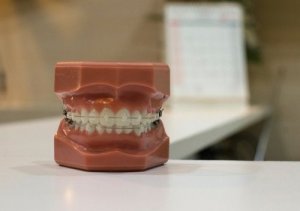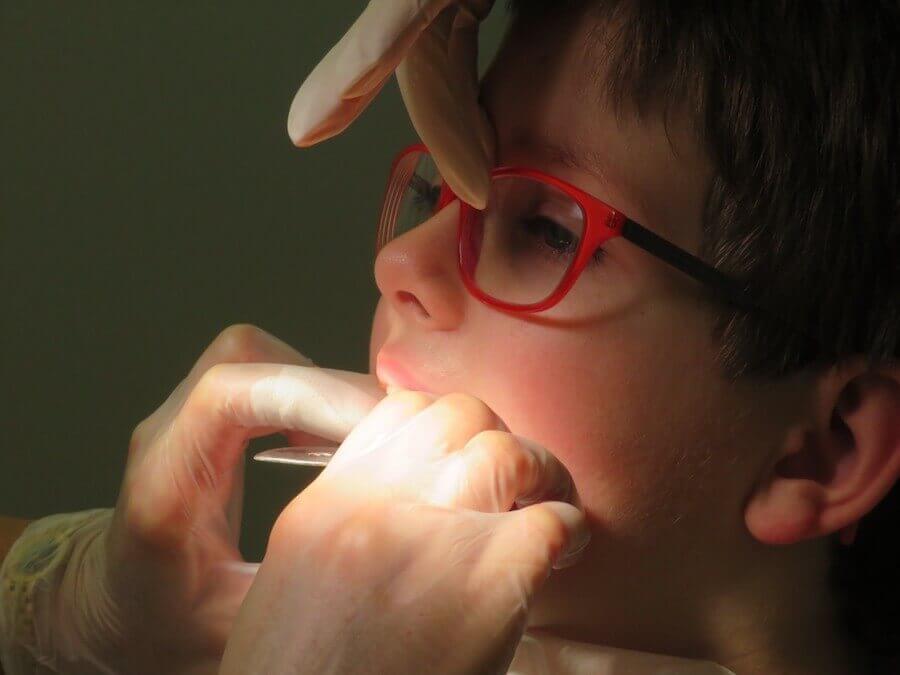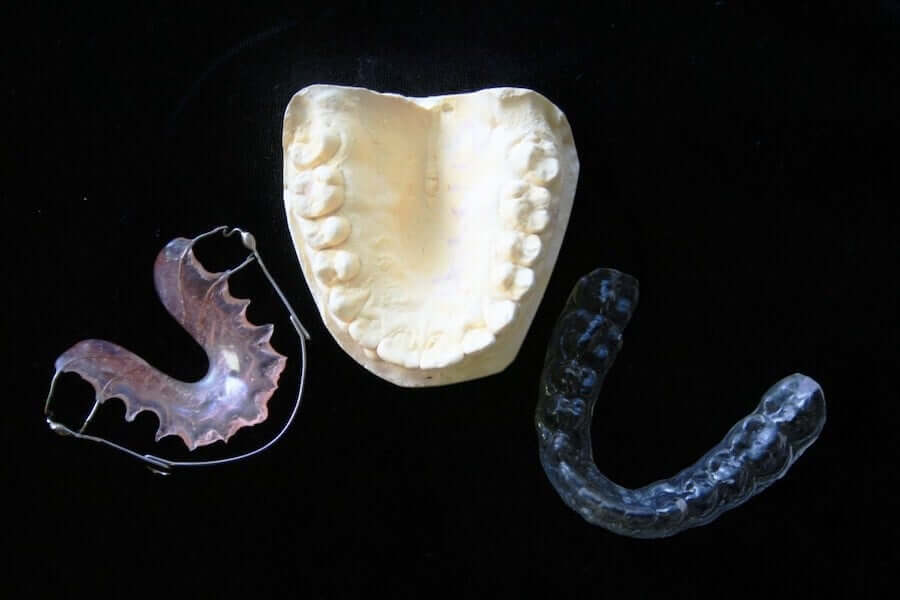Orthodontics for Children: Removable or Fixed

The different types of orthodontics for children focus on correcting skeletal issues and problems with facial development. It’s extremely important to take children to the dentist from the time they’re very young in order to avoid major problems in dental development.
However, each child may need a different type of orthodontic intervention. In the following article, we’ll offer some tips to help you know the different types and their function.
What problems do orthodontics correct in children?
Orthodontics for children are much more effective than interventions performed during adulthood. This is because children’s jaw bones are still growing and their dental structure has yet to adopt a fixed position. Orthodontic treatments can correct dental positioning and guide the exact growth of permanent teeth.
Furthermore, thanks to orthodontics, it’s possible to solve cases of overbite, wide palate and misalignment. In adults, these problems are difficult to correct. Therefore, it’s crucial that children receive the type of orthodontic treatment they need at the right age.

The first visit to the orthodontist
The ideal age for a child’s first visit to the orthodontist is between the ages of 5 and 7. During this initial consult, the professional will check the position of the jaw bones and the eruption of the child’s teeth.
The doctor will also look at the state of the child’s bite. This is the age when children’s first molars and incisors start to come in. Their bones are still malleable and they can easily be moved.
Preventive orthodontics
Not every case requires dental appliances. However, some of these cases still require preventative orthodontics.
Here, the specialist will intervene in order to correct certain harmful habits that negatively affect a child’s future dental development. For example, thumbs sucking, the prolonged use of a baby bottle or pacifier, or breathing through the mouth.
These actions may lead to a more open bite, jaw protrusion, or a wide or deformed palate. Therefore, an initial visit to the orthodontist at a young age is essential.
Types of orthodontics for children
There are various types of dental appliances that focus on correcting the teeth or craniofacial development. To know what your child needs, the orthodontist will study in order to determine the degree of the anomaly.
He or she will need to conduct a series of diagnostic tests, such as a panoramic X-ray, and intraoral and extraoral photographs. This way, the specialist will be able to establish an orthodontic plan. However, treatment can vary according to a child’s age.
Removable appliances
These orthodontic appliances serve to correct concrete alterations, and effectiveness depends on their constant use. This means that the more hours a child uses them, the better the result will be.
In general, they’re made of acrylic materials. This type of orthodontics for children attach through metal hooks on the child’s molars.
Removable orthodontic appliances are much more comfortable. Children can take them out in order to eat and brush their teeth. However, they need to possess the discipline and responsibility to put them back in. If they forget, or manage to lose or break their appliance, this will only make the treatment process longer.
There are two types of removable dental appliances. One type is for daytime and nighttime use, while the other is only for use at night. Nighttime appliances are most common for cases in which only mild modifications are necessary.

Fixed appliances
Fixed appliances remain attached to the child’s teeth. The most well-known type of fixed dental appliances are braces. This type of orthodontics corrects and redirects bone growth.
Fixed appliances consist of small metal brackets that attach to the outside of the teeth. A thin metal wire connects each row of brackets, and is responsible for modifying the teeth. The orthodontist will tighten or loosen the wires regularly so they fulfill their purpose.
Within the category of fixed appliances is esthetic or sapphire braces. In this case, the brackets are completely transparent, don’t change in color, and are very resistant. In fact, the wires are usually crystalline, so treatment requires specific care in order to obtain fast results.
When children must use fixed dental appliances, it’s fundamental for their parents to teach them the importance of good hygiene.
The different types of orthodontics for children focus on correcting skeletal issues and problems with facial development. It’s extremely important to take children to the dentist from the time they’re very young in order to avoid major problems in dental development.
However, each child may need a different type of orthodontic intervention. In the following article, we’ll offer some tips to help you know the different types and their function.
What problems do orthodontics correct in children?
Orthodontics for children are much more effective than interventions performed during adulthood. This is because children’s jaw bones are still growing and their dental structure has yet to adopt a fixed position. Orthodontic treatments can correct dental positioning and guide the exact growth of permanent teeth.
Furthermore, thanks to orthodontics, it’s possible to solve cases of overbite, wide palate and misalignment. In adults, these problems are difficult to correct. Therefore, it’s crucial that children receive the type of orthodontic treatment they need at the right age.

The first visit to the orthodontist
The ideal age for a child’s first visit to the orthodontist is between the ages of 5 and 7. During this initial consult, the professional will check the position of the jaw bones and the eruption of the child’s teeth.
The doctor will also look at the state of the child’s bite. This is the age when children’s first molars and incisors start to come in. Their bones are still malleable and they can easily be moved.
Preventive orthodontics
Not every case requires dental appliances. However, some of these cases still require preventative orthodontics.
Here, the specialist will intervene in order to correct certain harmful habits that negatively affect a child’s future dental development. For example, thumbs sucking, the prolonged use of a baby bottle or pacifier, or breathing through the mouth.
These actions may lead to a more open bite, jaw protrusion, or a wide or deformed palate. Therefore, an initial visit to the orthodontist at a young age is essential.
Types of orthodontics for children
There are various types of dental appliances that focus on correcting the teeth or craniofacial development. To know what your child needs, the orthodontist will study in order to determine the degree of the anomaly.
He or she will need to conduct a series of diagnostic tests, such as a panoramic X-ray, and intraoral and extraoral photographs. This way, the specialist will be able to establish an orthodontic plan. However, treatment can vary according to a child’s age.
Removable appliances
These orthodontic appliances serve to correct concrete alterations, and effectiveness depends on their constant use. This means that the more hours a child uses them, the better the result will be.
In general, they’re made of acrylic materials. This type of orthodontics for children attach through metal hooks on the child’s molars.
Removable orthodontic appliances are much more comfortable. Children can take them out in order to eat and brush their teeth. However, they need to possess the discipline and responsibility to put them back in. If they forget, or manage to lose or break their appliance, this will only make the treatment process longer.
There are two types of removable dental appliances. One type is for daytime and nighttime use, while the other is only for use at night. Nighttime appliances are most common for cases in which only mild modifications are necessary.

Fixed appliances
Fixed appliances remain attached to the child’s teeth. The most well-known type of fixed dental appliances are braces. This type of orthodontics corrects and redirects bone growth.
Fixed appliances consist of small metal brackets that attach to the outside of the teeth. A thin metal wire connects each row of brackets, and is responsible for modifying the teeth. The orthodontist will tighten or loosen the wires regularly so they fulfill their purpose.
Within the category of fixed appliances is esthetic or sapphire braces. In this case, the brackets are completely transparent, don’t change in color, and are very resistant. In fact, the wires are usually crystalline, so treatment requires specific care in order to obtain fast results.
When children must use fixed dental appliances, it’s fundamental for their parents to teach them the importance of good hygiene.
All cited sources were thoroughly reviewed by our team to ensure their quality, reliability, currency, and validity. The bibliography of this article was considered reliable and of academic or scientific accuracy.
- Zamora O, & Moran S. (2016). Revista Latinoamericana de Ortodoncia y Odontopediatría. Revista Latinoamericana de Ortodoncia, 8(1), 1–17
This text is provided for informational purposes only and does not replace consultation with a professional. If in doubt, consult your specialist.








